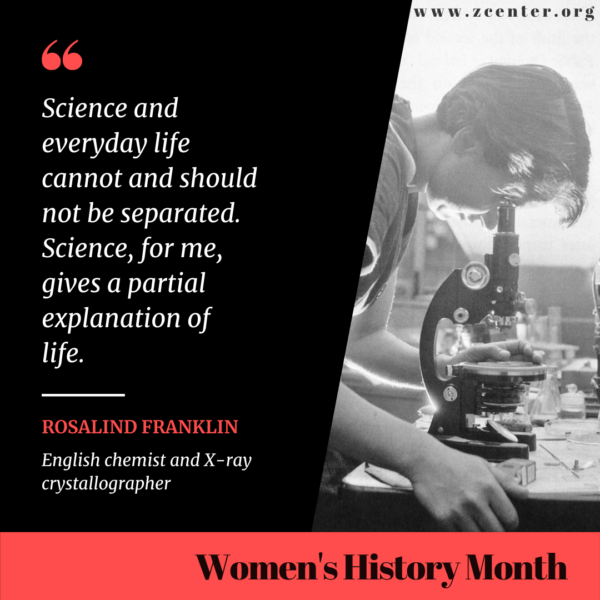The month of March is Women’s History Month and so we are focusing on forgotten voices of women throughout history. This week, we’re highlighting the work of an incredibly influential woman who is only spoken of briefly in biology courses despite her huge accomplishments. Seventy years ago, a young Rosalind Franklin looked over an X-Ray photograph and discovered something that would go on to change how we understand life. This discovery eventually led to a university here in Lake County, IL being named after her. Unfortunately, even though her legacy lives on locally, she also got the very raw end of the deal when it comes to her own discovery.
Franklin was born in Notting Hill, London in 1920. At the beginning of her life, her family noticed how quickly she had picked up a love and understanding of maths and sciences, her intelligence even surpassing those subjects and eventually mastering the French, Italian, and German languages. It was only at the age of 16 that Franklin began to dedicate her time to science entirely. Majoring in physical chemistry at one of the only women’s colleges, Newnham College at Cambridge University, Franklin immediately went on to work as a research assistant with the British Coal Utilisation Research Association (BCURA) after her bachelor’s degree. At BCURA, she studied the absorption of coal and the research she did eventually led her into her dissertation for her doctorate degree in 1945.
After earning her doctorate, Franklin was accepted into a position at Paris’ Laboratoire Central des Services Chimiques de l’Etat, where she worked on X-Ray imagery, leading her to her primal discovery just a short few years later in 1951. While studying DNA structure with assistant Raymond Gosling, Franklin discovered that DNA had a double helix structure in a photo now branded Photograph 51, serving as the evidence for the new understanding of DNA. Unfortunately, a colleague showed this photograph to James Watson, who took the evidence to further prove his and Francis Crick’s own research on the structure without Franklin’s permission. They went on to publish a paper on the structure of DNA with no credit given to Franklin, despite her photograph being a prominent factor of evidence.
Franklin continued on to new areas of research, publishing a number of papers on viruses in the five years after her discovery. The impact of her work helped build many foundations of understanding viral structure, which was incredibly important to physiological research. Still, Watson and Crick went on to receive a Nobel Prize in Physiology and Medicine years after Franklin’s death from ovarian cancer in 1958, giving no credit to Franklin.
Rosalind Franklin is only one account of women’s voices being lost within the larger influence of men, having not been acknowledged for this contribution until after her death, and while it may not be the last, there is power in recognizing those lost voices. This month we have highlighted multiple women that paved the way for so many others in history. Join ZCenter as we strive to keep these voices alive while raising up the voices of women today.
Works Referenced:
Maisel, M., & Smart, L. (1997). Rosalind Elsie Franklin: Pioneer molecular biologist. Retrieved
March 22, 2021, from https://www.sdsc.edu/ScienceWomen/franklin.html
Rosalind Franklin: A Crucial Contribution. (2014). Retrieved March 22, 2021, from
https://www.nature.com/scitable/topicpage/rosalind-franklin-a-crucial-contribution-6538012/
Rosalind Franklin: Biographical Overview. (n.d.). Retrieved March 19, 2021, from
https://profiles.nlm.nih.gov/spotlight/kr/feature/biographical
Written by Haley Olson, Outreach Intern
All ZCenter blog posts are written by state certified staff, interns, and volunteers. For questions on authorship or content, please email kjones@zcenter.org.

